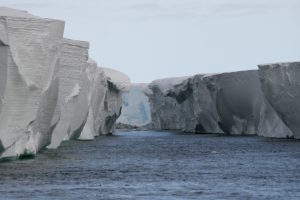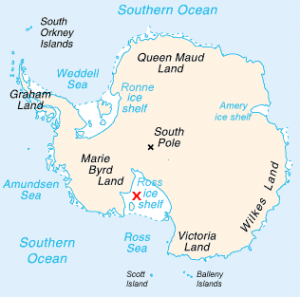24 October 2016
WASHINGTON, DC — Low-frequency vibrations of the Ross Ice Shelf are likely causing ripples and undulations in the air above Antarctica, a new study finds. Using mathematical models of the ice shelf, the study’s authors show how vibrations in the ice match those seen in the atmosphere, and are likely causing these mysterious atmospheric waves.

Like all floating ice, about 90% of the Ross Ice Shelf is hidden underwater. In some places, the ice is as much as several hundred meters thick.
Credit: lin padgham, Public Domain
Scientists at McMurdo Station detected unusual atmospheric waves with an altitude between 30 to 115 kilometers (20 to 70 miles) above Antarctica in 2011. The waves, which have a long period and take hours to cycle, were observed for several years. Scientists routinely observe atmospheric waves around the world, but the persistence of these waves made them unusual, and scientists didn’t know what was causing them.
The new research solves this mystery by connecting the atmospheric waves to vibrations of the Ross Ice Shelf – the largest ice shelf in the world with an area of almost half a million square kilometers (188,000 miles), roughly the size of France. Imperceptible vibrations of the ice shelf, caused by ocean waves and other forces, are transferred and amplified in the atmosphere, according to the new study.
If the study’s predictions are correct, scientists could use these atmospheric waves to measure properties of the ice shelf that are normally difficult to track, such as the amount of stress the ice shelf is under from ocean waves.
“If atmospheric waves are generated by ice vibrations, by rhythmic vibrations of ice—then that carries a lot of information of the ice shelf itself,” said Oleg Godin, a professor at the Naval Postgraduate School in Monterey, California, and lead author of the new study, published in the Journal of Geophysical Research: Space Physics, a journal of the American Geophysical Union.

A map of Antarctica with a marker designating the location of the Ross Ice Shelf. Credit: Jeandré, Public Domain
This information could help scientists better understand the status and stability of ice shelves, which are permanently floating sheets of ice connected to landmasses. Scientists closely monitor the size and movement of ice shelves because when they break up, they indirectly contribute to sea level rise through their impact on land ice.
“Ice shelves buffer or restrain land ice from reaching the ocean,” said Peter Bromirski, a research oceanographer at Scripps Institution of Oceanography at UC San Diego in La Jolla, California, who was not involved in the new study. “The long term evolution of an ice shelf—whether or not it breaks up and disintegrates—is an important factor in how fast sea level will rise.”
Explaining the vibrations
In the new study, Godin and his co-author, Nikolay Zabotin, used two theoretical models of the Ross Ice Shelf to show vibrations within the ice could create the atmospheric waves.
One model approximates the ice shelf as a smooth rectangular slab of ice, while the other approximates the ice as a layered fluid. The authors incorporated known properties of the ice sheet such as elasticity, density, and thickness into each model to calculate the time it would take vibrations in the ice to complete one cycle.
They found both models predict that the ice shelf produces vibrations within a 3- to 10-hour period, which matches the duration of vibrations seen in the atmosphere. These ice shelf vibrations would likely also produce atmospheric waves with a vertical wavelength of 20 to 30 kilometers (12 to 18 miles), another feature of the observed waves.
“Even in this simplified description [of the ice], it readily explains the most prominent features of the observations,” Godin said. “That’s why it goes beyond hypothesis. I would say it’s now a theory.”
The vibrations are transferred from the ice shelf to the atmosphere through direct contact with the air above the ice shelf, according to the new study. While the vibrations of the ice sheet are small, the atmospheric disturbances they create can be large because of reduced air pressure high in the atmosphere. For example, an ice shelf vibration one centimeter in amplitude pushes on the air directly above it. As the vibration cascades upward, it can grow in amplitude to move air hundreds of meters up and down when the wave reaches the less-dense air high in the atmosphere, Godin said.
The size of these atmospheric waves makes them easy to observe with radar and Lidar, a radar-like system using laser light to scan the atmosphere. Godin and Zabotin plan to use an advanced research radar to study the atmospheric waves in more detail to better understand the behavior of the Ross Ice Shelf.
“There are suggestions in the literature that accelerated breakup of ice shelves will lead to rise of sea level by several meters by the end of the century,” Godin said. “Anything we can do to quantify what is going on with these large ice shelves is of huge importance.
The research was primarily funded the Basic Research Challenge program of the Office of Naval Research and utilized the research computing facility at the University of Colorado Boulder, which is supported by the National Science Foundation.
###
The American Geophysical Union is dedicated to advancing the Earth and space sciences for the benefit of humanity through its scholarly publications, conferences, and outreach programs. AGU is a not-for-profit, professional, scientific organization representing more than 60,000 members in 139 countries. Join the conversation on Facebook, Twitter, YouTube, and our other social media channels.
Notes for Journalists
This research article is open access for 30 days. A PDF copy of the article can be downloaded at the following link: http://onlinelibrary.wiley.com/doi/10.1002/2016JA023226/pdf.
After 30 days, journalists and public information officers (PIOs) of educational and scientific institutions who have registered with AGU can download a PDF copy of the article from the same link.
Journalists and PIOs may also order a copy of the final paper by emailing a request to Daniel Garisto at [email protected].
Please provide your name, the name of your publication, and your phone number.
Neither the paper nor this press release is under embargo.
“Ice shelf vibrations cause unusual waves in Antarctic atmosphere”
Authors:
Oleg Godin: Department of Physics, Naval Postgraduate School, Monterey, California, U.S.A.;
Nikolay Zabotin: Department of Electrical, Computer, and Energy Engineering, University of Colorado Boulder, Boulder, Colorado, U.S.A.
Contact Information for the Authors:
Oleg Godin: [email protected], (831) 656-2982
Daniel Garisto
+1 (202) 777-7494
[email protected]